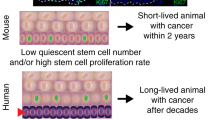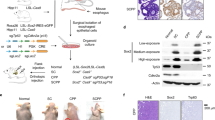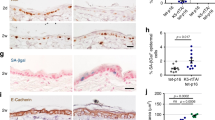Abstract
Our previous work showed that acquisition of immortality at the dysplasia stage of oral cancer progression was consistently associated with four changes: loss of retinoic acid receptor (RAR)-β and p16INK4A expression, p53 mutations and activation of telomerase. One atypical dysplasia (D17) that underwent delayed senescence after an extended lifespan showed loss of RAR-β and p16INK4A/p14ARF expression, but retained functional wild-type p53 and telomerase was not activated. We now demonstrate that retroviral delivery of hTERT results in telomere lengthening and immortalization of D17 without loss of functional wild-type p53 activity. In contrast, the expression of hTERT in two other typical mortal dyplasia cultures (that retain RAR-β and p16INK4A expression) does not extend their lifespan, even though telomeres are lengthened.
This is a preview of subscription content, access via your institution
Access options
Subscribe to this journal
Receive 50 print issues and online access
$259.00 per year
only $5.18 per issue
Buy this article
- Purchase on Springer Link
- Instant access to full article PDF
Prices may be subject to local taxes which are calculated during checkout




Similar content being viewed by others
References
Campisi J . (2000). In vivo, 14, 183–188.
Ghose A, Fleming J, El-Bayoumy K and Harrison PR . (2001). Cancer Res., 61, 7479–7487.
Gordon KE, Ireland H, Roberts M, Steegs K, McCaul JA, MacDonald DG and Parkinson KE . (2002). Cancer Res., 63, 458–467.
Kresty LA, Mallery SR, Knobloch TJ, Song H, Lloyd M, Casto BC and Weghorst CM . (2002). Cancer Res., 62, 5295–5300.
Lustig AJ . (1999). Proc. Natl. Acad. Sci. USA, 96, 3339–3341.
McGregor F, Muntoni A, Fleming J, Brown J, Felix DH, MacDonald G, Parkinson EK and Harrison PR . (2002). Cancer Res., 62, 4757–4766.
McGregor F, Wagner E, Felix D, Soutar D, Parkinson K and Harrison PR . (1997). Cancer Res., 57, 3886–3889.
Morris M, Hepburn P and Wynford-Thomas D . (2002). Oncogene, 21, 4277–4288.
Munro J, Steeghs K, Morrison V, Ireland H and Parkinson EK . (2001). Oncogene, 20, 3541–3552.
Munro J, Stott FJ, Vousden KH, Peters G and Parkinson EK . (1999). Cancer Res., 59, 2516–2521.
Ohtani N, Zebedee Z, Huot TJ, Stinson JA, Sugimoto M, Ohashi Y, Sharrocks AD, Peters G and Hara E . (2001). Nature, 409, 1067–1070.
Pandita TK . (2002). Oncogene, 21, 611–618.
Papadimitrakopoulou V, Izzo J, Lippman SM, Lee JS, Fan YH, Clayman G, Ro JY, Hittelman WN, Lotan R, Hong WK and Mao L . (1997). Oncogene, 14, 1799–1803.
Ramirez RD, Morales CP, Herbert BS, Rohde JM, Passons C, Shay JW and Wright WE . (2001). Genes Dev., 15, 398–403.
Rheinwald JG and Beckett MA . (1981). Cancer Res., 41, 1657–1663.
Rheinwald JG, Hahn WC, Ramsey MR, Wu JY, Guo Z, Tsao H, De Luca M, Catricala C and O'Toole KM . (2002). Mol. Cell. Biol., 22, 5157–5172.
Serrano M, Lin AW, McCurrach ME, Beach D and Lowe SW . (1997). Cell, 88, 593–602.
Shay JW . (1997). J. Cell. Physiol., 173, 266–270.
Smogorzewska A and de Lange T . (2002). EMBO J., 21, 4338–4348.
Stewart SA and Weinberg RA . (2002). Oncogene, 21, 627–630.
Vaziri H and Benchimol S . (1998). Curr. Biol., 8, 279–282.
Webley K, Bond JA, Jones CJ, Blaydes JP, Craig A, Hupp T and Wynford-Thomas D . (2000). Mol. Cell. Biol., 20, 2803–2808.
Xu D, Wang Q, Gruber A, Bjorkholm M, Chen Z, Zaid A, Selivanova G, Peterson C, Wiman KG and Pisa P . (2000). Oncogene, 19, 5123–5133.
Xu XC, Ro JY, Lee JS, Shin DM, Hong WK and Lotan R . (1994). Cancer Res., 54, 3580–3587.
Acknowledgements
We are grateful to Dr H Vaziri for his generous gift of the hTERT retroviral construct. We are grateful to Professors J Wyke and B Ozanne for critically reading the manuscript. AM was supported by the Glasgow Cancer School and White Lily Trust; PRH, KEP, JF and KG by Cancer Research UK and KH by Glasgow University.
Author information
Authors and Affiliations
Corresponding author
Rights and permissions
About this article
Cite this article
Muntoni, A., Fleming, J., Gordon, K. et al. Senescing oral dysplasias are not immortalized by ectopic expression of hTERT alone without other molecular changes, such as loss of INK4A and/or retinoic acid receptor-β: but p53 mutations are not necessarily required. Oncogene 22, 7804–7808 (2003). https://doi.org/10.1038/sj.onc.1207085
Received:
Revised:
Accepted:
Published:
Issue Date:
DOI: https://doi.org/10.1038/sj.onc.1207085
Keywords
This article is cited by
-
The secreted protein S100A7 (psoriasin) is induced by telomere dysfunction in human keratinocytes independently of a DNA damage response and cell cycle regulators
Longevity & Healthspan (2014)
-
Expression of hTERT immortalises normal human urothelial cells without inactivation of the p16/Rb pathway
Oncogene (2006)
-
Profiling early head and neck cancer
Nature Reviews Cancer (2005)



